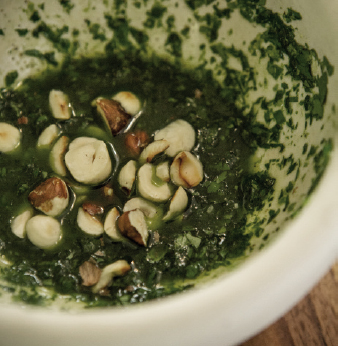ROASTED PARSNIPS WITH HAZELNUT PESTO
SERVES 4
PARSNIPS, LIKE CARROTS, get sweeter as they roast. In this recipe, I raise the heat to char the outside (grilling does that, too), heightening the experience of eating the soft, creamy parsnips inside. I feel strongly that parsnips (and other root vegetables, for that matter) should be roasted in a heavy skillet, not on a thin baking sheet.
Skillets are designed to transfer heat properly; their flat surface browns vegetables evenly on contact. They won’t bend or warp under the heat, and they won’t throw off odors as baking sheets might. This is good cooking! It’s why grandma’s frying pans were so heavy and why enameled cast-iron, stainless-steel-clad, or copper cookware is worth investing in. It’s what makes food taste good.
The Hazelnut Pesto is a great partner for these rustic parsnips, but I also like it drizzled over Escarole Salad with Fennel & Pears (here), on Sliced Raw Jerusalem Artichoke Salad (here), and with Roasted Whole Leeks (here). To maximize the pesto’s fresh flavor, make it in small quantities in a mortar and pestle.
4 parsnips, peeled
Salt and pepper
¼ cup roughly chopped fresh flat-leaf parsley
¼ cup roughly chopped fresh cilantro
1 large clove garlic, minced
¼ cup toasted and skinned hazelnuts, halved
Preheat the oven to 400°F. Heat 2 tablespoons of the oil in a large ovenproof skillet over medium-high heat. Add the parsnips, salt, and pepper and cook, turning them a few times, until they start to brown, about 3 minutes. Pop the skillet into the oven and roast until the parsnips are tender, about 40 minutes.
Meanwhile, in a mortar, combine the parsley, cilantro, garlic, and salt. Smash into a coarse paste while drizzling in the remaining 4 tablespoons oil, then stir in the nuts. Cut the roasted parsnips in half lengthwise and spoon on the pesto.
